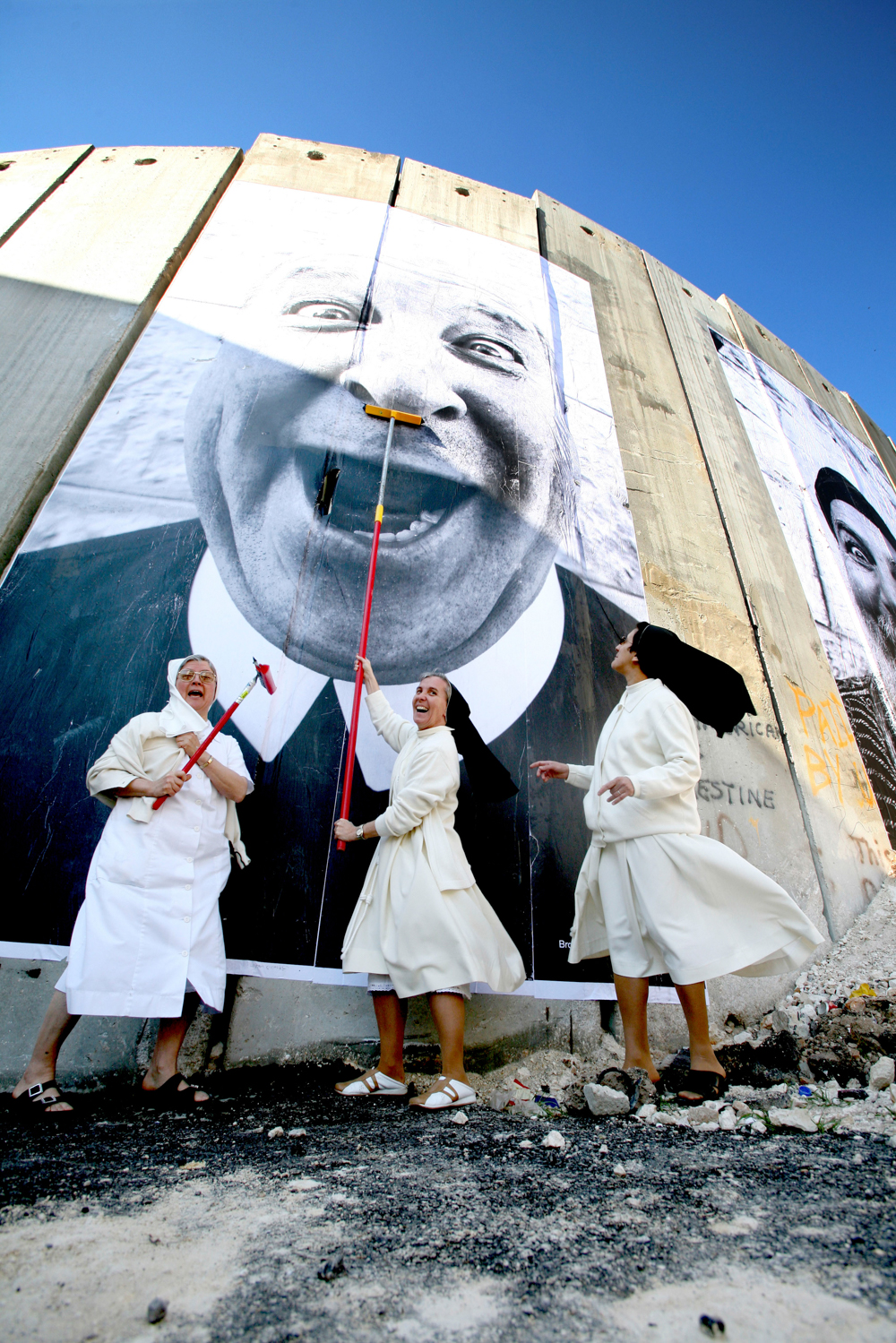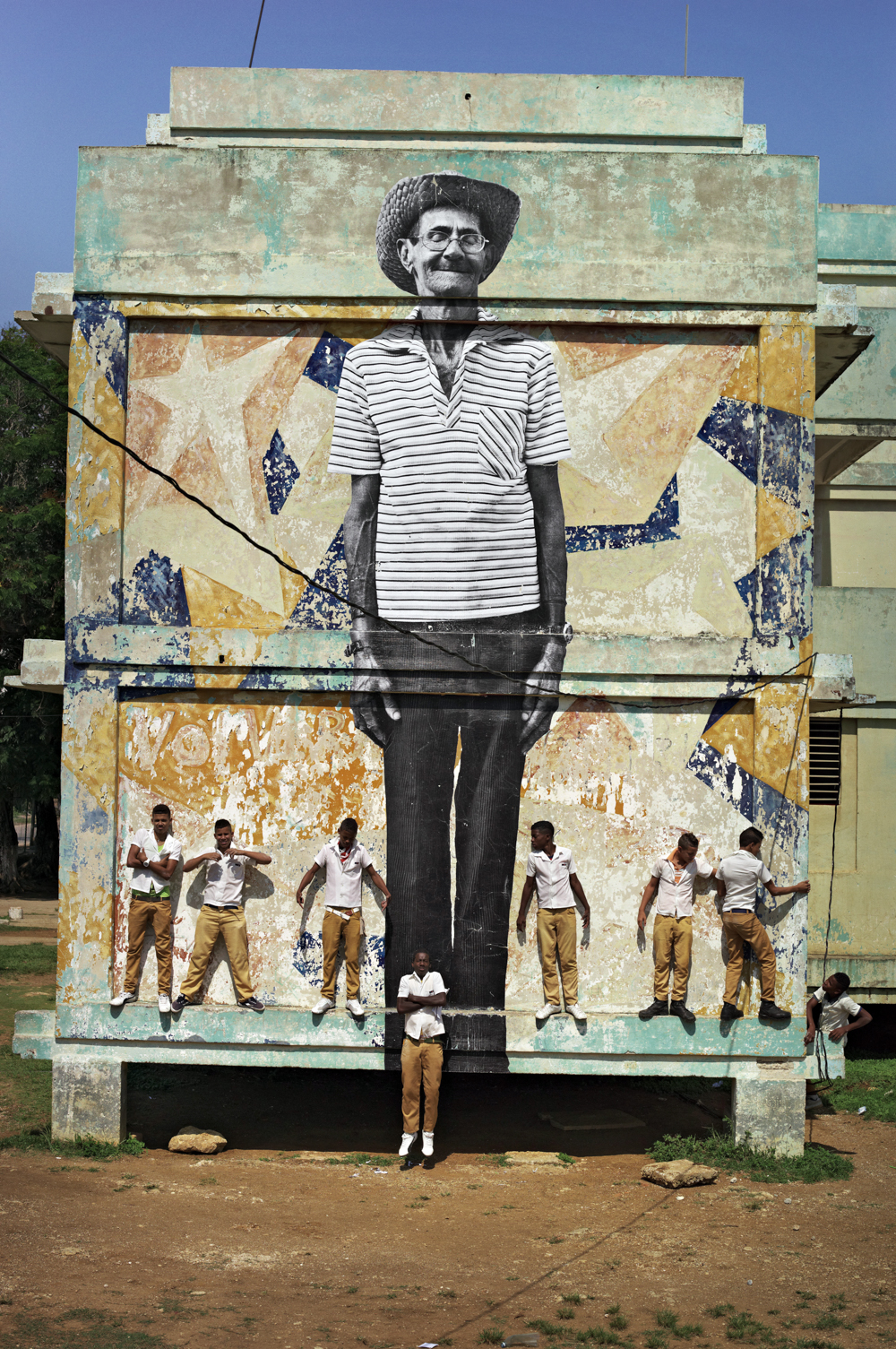IMPACT | JR: Dignity
JR, The Wrinkles of the City, Berlin, Soho House, Herr Zyla, Germany, 2013 Color photograph, matte plexiglass, aluminum, wood 180 x 120 cm | 70 3/4 x 47 1/4 in. Courtesy of ©JR-ART.NET
By Ashley Yu
No longer called “graffiti,” the etymology of the phrase “street art” emerged from the back alleys of inner cities; from the murky confines of subway tunnels, invisible until the sudden blaze of headlights of an oncoming train; from the crumbling drywall of abandoned buildings, esconcing spray-painted names of strangers long gone. The romantic ideal of graffiti as the rite of passage for teenage delinquency, as the symbol for rebellion against “The System,” is just that: an ideal. Graffiti has migrated into the realm of corporate capitalism, in the form of commissioned murals for brands like Coronas and Dior; gallery pieces to be hung on sterilized walls, later auctioned off for millions; and, in the case of Frank Shepard Fairey (i.e. the OBEY guy), a luxury streetwear brand. As street art slowly transforms into yet another gentrified fad, it has also blunted its bite—except, perhaps, in the case of the elusive JR.
A few years ago, JR was an enigmatic, lesser-known personality, attracting the inquiring eyes of a few within the underground art scene. Now, JR has skyrocketed to international fame over the years, generating a litany of high-profile pieces. His works have been featured on 60 Minutes with Anderson Cooper, in the Oscar-nominated documentary Faces Places with the iconic Agnés Varda, and most recently in the Emmy-nominated project with TIME magazine Guns in America. They have also appeared as installations at the Louvre in Paris, Times Square in New York, and at the U.S.-Mexico border.
JR, The Wrinkles of the City, Berlin, Augustrasse, Dr Shihab, Ahmen, Germany, 2013, Color photograph, matte plexiglass, aluminum, wood, 180 x 120 cm | 70 3/4 x 47 1/4 in. Courtesy of ©JR-ART.NET
Donned in his trademark fedora, sunglasses, and a full name that only his arresting police officers would know, the origins of this quasi-anonymous street artist trace back to the housing projects of Les Bosquets in the outskirts of Paris. Ironic to think that JR, who was so far removed from the luxuries of the bourgeoisie, is now beloved by that very class. As the hallmark for any disgruntled youth, JR began scrambling over subway tracks and rooftops with his friends, spray-paint in hand. Though he admits that his own graffiti skills were subpar, he turned, instead, to documenting and photographing his friends’ illegal forays, after finding a camera on the Paris Metro.
That abandoned camera would begin to shape JR’s distinctive style, which consists of pasting massive monochromatic portraits, especially shortly before the 2005 French riots—a violent three-week-long protest, mostly amongst the youth in the outskirts of Paris and other French cities, against the police’s racially-motivated brutality. In his 2011 TED Talk, JR recalled his surprise towards the media’s portrayal of French Muslims and North African immigrant teenagers as brutal monsters, terrorizing Paris’ bourgeois citizens—teenagers that JR lived with and befriended in his childhood arrondissement. Determined to topple the bigots off their racist high horse, JR captured the portraits of young people from the housing project. In lieu of kitschy, feel-good photographs, JR asked his subjects to pretend to be the monsters the media wanted them to be. They were caricatures of hoodlums with bared teeth and shotguns. This project, Portrait of a Generation, would be the one that made his name. JR would guerrilla the miscellaneous buildings of Paris. By pasting prints of his three-story-tall portraits that towered over pedestrians on vacant walls, he put a generation of disenfranchised, marginalized immigrants onto the same lofty pedestal as the Notre Dame or the Champs-Élysées. Visible from a mile away, JR carved for his friends a space of visibility to be recognized by the citizens of Paris, without the exorbitant museum entry fees and all the cultural currency that comes along with it. This risqué project would be JR’s first installation to be legalized by the city council with the portraits encircling the ancient façade of the Paris City Hall.
JR, 28 Millimétres; Women Are Heroes, Pasting in Monrovia streets, Liberia, 2008, Color photograph, matte plexiglass, aluminum, wood, 125 x 222 cm | 49 1/4 in x 7.3 ft. Courtesy of ©JR-ART.NET
“Art can’t change the practical things of the world,” confessed JR during his TED Talk in his molasses-thick French accent, “but art creates energy. It can change perceptions and that enables it to change the world.” From his first public project onwards, JR has been consistently loyal to his original artistic vision to unite a community and challenge widely propagated, often prejudiced, worldviews. To provide an alternate narrative and question mainstream mode of thought seems to be JR’s modus operandi.
Motivated by the stories of strangers he has carried with him, his print-and-paste photographs transcend any political agenda or pithy phrase. Take his most retold story about his Face 2 Face project, which was also the largest unauthorized urban art exhibit in the world. While the Israeli-Palestinian conflict was (arguably) at its zenith in the early 2000s, JR braved the rockets’ red glare, traveling to the Israeli West Bank (i.e. the separation wall between Israel and Palestine). Months prior to the outbreak of the bloody Battle of Gaza in 2007, JR and his collaborator Marc “Marco” Berribi pasted portraits of civilian Israelis and Palestinians next to each other on both sides of the separation barrier. Much to the street artist’s glee, when he asked crowds of onlookers on both sides of the border to identify which portrait was of a Palestinian and which of an Israeli, nobody could.
JR, 28 Millimétres; Face 2 Face, Nuns in action, Separation wall, security fence, Palestinian side, Bethlehem, 2007, Color photograph, matte plexiglass, aluminum, wood, 105 x 70 cm | 41 5/16 x 27 9/16 in. Courtesy of ©JR-ART.NET
In the words of Marco, Israelis and Palestinians are “like twin brothers raised in different families...a farmer, a taxi driver, a teacher, has his twin brother in front of him. And he is endlessly fighting with him.” In the grander scheme of the war, did JR and Marco overturn decades of perennial violence and slaughter? Of course not. But he has invited pedestrians, jaded by years of turmoil, to pause and stare, face to face, at their neighbor across the concrete wall.
Humanitarian projects such as these often see JR categorized as a social activist, yet that is a label he passively and amiably accepts. His simple wish is to unite a community and question what it means to be part of one. As we, in the United States, approach a near-deafening immigration crisis, JR erected yet another illegal installation at the border town of Tecate in September 2017. Mounted on impromptu scaffolding thirty feet tall, the image of a one-year-old Mexican boy named Kikito peers curiously over the rickety wooden fence that separates the Americas. Earlier in 2014, the archival photographs of immigrants were pasted onto the walls of the dilapidated hospital on Ellis Island, the prototype of our (Trump’s) modern immigrant detention centres. JR staged huddled figures to stare out a window towards the Statue of Liberty. Over time, these paper figures have faded and melded into the brick walls of the island.
The Wrinkles of the City, La Havana, Antonio Cruz Gordillo, (artwork by JR, project by JR & José Parlá) Cuba , 2012, Color photograph, matte plexiglass, aluminum, wood, 267 x 180 cm | 105 1/8 x 70 3/4 in. © Courtesy of ©JR-ART.NET
JR’s show at the Brooklyn Museum will run from October 4, 2019–May 3, 2020.
For more of this interview, check out the feature in our previous issue entitled “IMPACT” here.












